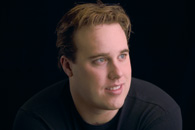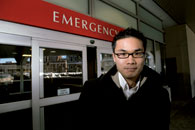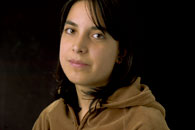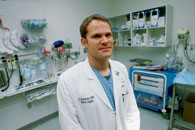After The Fire
More than two years have passed since The Station nightclub fire in West Warwick, R.I., claimed 100 lives, but the story continues. Victims’ families meet in support groups. The club owners will go on trial on criminal charges next year. A massive civil suit names 47 defendants, from the club owners to the beer company that provided the banner announcing the tragic Feb. 20 concert by the band Great White.
The fire lingers, too, in the hearts and minds of four Bates people — including Phil Barr ’05, burned in the blaze — whose paths crossed that night at Rhode Island Hospital, in Providence. Details of the strange reunion in the chaotic whirl vary with the story’s teller. But one thing is certain: the concern they felt for each other, heightened by their shared Bates background.
The patient

Phil Barr ’05 wasn’t supposed to be in Rhode Island on Feb. 20, 2003. He had spent winter break in New York City interviewing for banking internships, but a mammoth snowstorm shut down the city and sent him home to Lincoln. He called a buddy, Evan Clabots, to meet at The Station, a roadhouse known for ’80s-style rock shows. Looking forward to their reunion, Barr arrived early and grabbed a spot near the stage. In what seems like prescience, he noted an exit on the far wall, a space soon to be obscured in the shoulder-to-shoulder crowd.
Instinctively, Barr abandoned his path for the front entrance — most of the 96 people who died that night would be found there — and steered Clabots toward the exit he’d noticed earlier. The flames were already overhead; molten ceiling dripped on his shoulders. Choking in the acrid black smoke, he practiced the breath control he’d honed as a varsity swimmer at Bates. He was on his fourth breath when he tripped on a stool and, overrun by a screaming human wave, passed out. Waking to the belief that his back was on fire, he pushed a body off him in an adrenergic surge and groped his way along a wall until he tumbled out a door into the snow.
Clabots, who’d been pulled through a window to safety, found Barr sitting by a fire truck, hysterically screaming on his cell phone. His face and neck were scorched. He was coughing up soot and blood. He wanted Clabots to drive him home. Clabots instead took him to the makeshift triage center cross the street, where EMTs ministered oxygen and placed him in an ambulance bound for Rhode Island Hospital.
The emergency room entrance was a tumult of television lights and screaming ambulances. Asked to sign a form, Barr reached for his wallet and noticed a basketball-sized blister on his back. He was wheeled face down to a trauma bay where, distressed and breathing painfully, he waited amid the bustle of people in scrubs and gurneys bearing scorched bodies.
That’s when he saw Joe Chan ’04.
The students

Joe Chan was unnerved by the flicker of recognition he saw in the eyes of a burn patient. He and Naira Arellano ’05 had been watching Dr. Eric Halvorson ’92 perform an escharotomy — slicing through burn-toughened skin to relieve deadly fluid buildup — when yet another victim, a young man, was rolled into the bay. “I thought he was a stranger,” Chan says. “Then suddenly the stranger called out my name.”
Beneath the soot, Chan recognized Phil Barr, a friend since freshman year in Smith Hall. Barr’s skin was bright red, but that was good compared to the waxy yellow arms of the unconscious woman he’d just seen treated. “I was optimistic about Phil because on the surface, he wasn’t badly injured,” Chan says. “As it turned out, Phil’s skin belied his condition. His burns were internal.”

Chan, a biology major from Skokie, Ill., and Arellano, a neuroscience major from Sanford, N.C., were on the weeklong, Bates-sponsored Career Discovery Internship Program, which matches students with alumni in their work environment. Alongside Halvorson, the chief resident for the trauma service at RIH, and other physicians, the two students had worked long hours: attending conferences, observing surgeries, and wearing beepers so they wouldn’t miss emergency room activity, though there had been little of it. Feb. 20 was their last day; they were planning to stay all night.
Shortly before midnight, a page went out: hold the evening shift for mass casualties from a nightclub fire. Then another page called in all essential personnel. “They prepared for the worst,” Arellano says. “They opened rooms that weren’t usually treatment rooms. Joe and I were able to hand things as needed, to stock items, move beds.”
Then the patients began to arrive — “tons and tons of patients,” Arellano recalls. “As time passed their conditions got worse and worse. There was a strong smell of burned hair.” She was scrubbing the escharotomy patient’s blackened face when Barr croaked Chan’s name. “Joe went to him right away.”
“Once I saw Phil, the experience became very subjective,” says Chan, whose sense of powerlessness had to that point been tempered by emotional distance. “My whole perspective changed. As soon as I saw Phil, I knew I would stay with him.”
Chan’s was the last familiar face Barr would remember seeing before being placed in a three-week, medically induced coma.
The doctor

Eric Halvorson joined Chan at Barr’s side. For a second he allowed himself to feel stunned by the coincidence. “It was a Bates moment,” he recalls. “But nothing anyone would ever want to happen ever again.” Then he got to work. With patients arriving two or three to an ambulance, he could not dwell on the strange intersection of four Batesies’ lives in the immediate aftermath of the country’s fourth-deadliest nightclub fire. He would, however, play a major role in Barr’s treatment — and in reassuring two overwhelmed future doctors.
Chan and Arellano’s enthusiasm had impressed Halvorson. He was training in general surgery at Brown Medical School and saw CDIP as a way to repay his Bates teachers. “Both kids wanted so desperately to come. They were gung ho.”
Feb. 20 was Halvorson’s night off. He was nodding off to sleep when he was called to duty. Chan and Arellano, already in the ER, aligned with him as soon as he arrived. He was placed in charge of one of five trauma bays stabilizing and admitting patients. In all, 63 patients were treated at RIH; 43, including Barr, were admitted to the intensive care ward that now functioned as a burn unit. Halvorson was initially not overly concerned about Barr — “he was wide awake and looked fine” — but felt his scorched lungs bore watching. “He went on to show he had the worst inhalation injury of anyone.”
Barr was sedated and on a respirator when his frantic parents, Barbara and Philip Barr, found him about 2 a.m. under the watchful eye of Joe Chan. “At the worst time, Joe was the comfort, the familiar face, for Philip,” says Barbara. “He did as much as he could, with as little power that he had.”
Three days later, Barr experienced life-threatening pulmonary failure. His drug-induced coma was deepened and, to keep his lungs from collapsing, he was placed in a sling and flipped, front to back, back to front, every four hours. Several times a day, Halvorson inserted a bronchoscope into Barr’s lungs to remove soot and clotted blood.
Halvorson was present three weeks later when Barr, freed of the paralytic drug, at last opened his eyes, and he saw Barr go home a few days later to face months of healing. His work with station fire victims would continue for two more months. Later he would reflect on Feb. 20 and wonder about Joe Chan and Naira Arellano. “These were the most gruesome images I’d ever seen,” Halvorson says, “and there I was with these two college kids. They must have been scared.”
Looking forward
Arellano is grateful for the concern Eric Halvorson had for her and Chan. “He said, ‘If you found this exciting, that’s great, but this is not the everyday. And if you found it terrible and feel you can’t deal with it, there are a thousand branches of medicine where you never have to see this sort of thing.’”
Arellano’s dream to practice emergency medicine survived intact. After graduation, she will work as an EMT, earn her master’s degree in medical anthropology, and then attend medical school. “It was a great team effort,” she says of the RIH response, “and it was very sad. We left knowing that some people would be in the hospital for months, and some would suffer a lifetime of health problems. But we left the next day, so we don’t know what happened to them. The disassociation is surreal.”
Joe Chan’s interest in emergency pediatrics has not wavered either. He works as a research assistant in general medicine at Brigham and Women’s Hospital, in Boston, and takes the MCATs this spring. “I’m happy that fortune placed me where I could offer assurance and support to Phil,” he said. “He’s a courageous and tenacious character.”
Plunged into a de facto burn fellowship, Eric Halvorson quickly became comfortable with a practice most surgeons dread due to its grisly nature and high-maintenance patients. Halvorson expects to specialize in plastic reconstructive surgery, in which he is now training at Lahey Clinic in Massachusetts. “I don’t have to worry about learning burn surgery now,” he said. “I can manage this kind of surgery and I hope to do it in my practice.”
Strapping and handsome, Phil Barr does not look like a man who just spent a year recuperating from devastating injuries. The economics major returned to Bates in September 2004. He graduates this spring and starts work as an investment bank analyst at JP Morgan in New York. Despite having only 87 percent of his former lung capacity, Barr still swam with the varsity team this season and managed, he says with a grin, to avoid coming in last. “I’ve always been inclined to push myself,” he says. “I’ve always been inclined to take on challenges. This experience intensified that for me.”
“He goes as hard and as long as he can,” adds his coach, Dana Mulholland. “He has everyone’s respect.”
Being under Halvorson’s care at RIH was “pretty cool,” Barr says. It was unspoken, but Barr knew his Bates doc would have great expectations. “He was someone who was going to push me to recover as well as I could.”
He is especially grateful to Joe Chan, who brought comfort when it was expected least and needed most. “To see a familiar face at a moment like that and know it’s someone who cares about you, someone who looked after you in college, means a lot.
By Virginia Wright